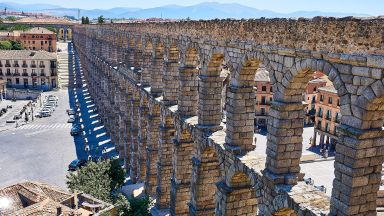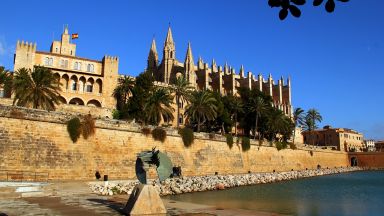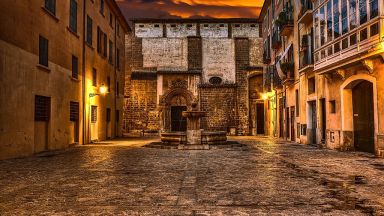Segovia: The Complete Guide
Segovia is a historic city northwest of Madrid, in central Spain’s Castile and León region. Its centuries of settlement have resulted in a rich architectural legacy, including medieval walls, Romanesque churches, a former royal palace and a Gothic cathedral. Its iconic ancient Roman aqueduct has more than 160 arches, most in the original mortarless granite, and stands above Plaza Azoguejo in the heart of the city.
Visiting Segovia for the first time and wondering what are the top places to see in the city? In this complete guide, I share the best things to do in Segovia on the first visit. Top help you plan your trip, I have also included an interactive map and practical tips for visiting!
This website uses affiliate links which earn a small commission at no additional cost to you.
16 Best places to See in Segovia
This complete guide to Segovia not only tells you about the very best sights and tourist attractions for first-time visitors to the city but also provide insights into a few of our personal favorite things to do.
This is a practical guide to visiting the best places to see in Segovia and is filled with tips and info that should answer all your questions!
Aqueduct of Segovia

Location: Aqueduct of Segovia Plaza del Azoguejo, 1 40001 Segovia Spain | Hours: 24 Hours | Price: Free | Distance: 0.90km
Visiting Aqueduct of Segovia
Plaza del Azoguejo

Visiting Plaza del Azoguejo
Casa de los Picos

Location: Casa De Los Picos C. Juan Bravo, 33 40001 Segovia Spain | Distance: 1.10km
Visiting Casa de los Picos
Iglesia San Juan de los Caballeros (Zuloaga Museum)

Location: Museo Zuloaga Pl. Colmenares, 4 40001 Segovia Spain View o | Hours: Oct 1-Jan 31 From Tuesday to Saturday 10:00-14:00 and 16:00-19:00.Jul 1-Sep 30From Tuesday to Saturday 10:00-14:00 and 17:00-20:00. Sundays 10:00 a.m.-2:00 p.m. | Price: Free entry | Distance: 1.20km
Visiting Iglesia San Juan de los Caballeros (Zuloaga Museum)
Torreón de Lozoya

Location: Torreón de Lozoya, Plaza San Martín, Segovia, Spain | Distance: 1.20km
Visiting Torreón de Lozoya
Plaza de Medina del Campo

Location: Pl. Medina del Campo, 2, 40001 Segovia, Spain | Distance: 1.30km
Visiting Plaza de Medina del Campo
Convento de Clarisas del Corpus Christi

Visiting Convento de Clarisas del Corpus Christi
Segovia Jewish Quarter

Visiting Segovia Jewish Quarter
Segovia Plaza Mayor

Location: Plaza Mayor, Segovia, Spain | Distance: 1.50km
Visiting Segovia Plaza Mayor
Segovia Cathedral

Location: Catedral de Segovia C. Marqués del Arco, 1 40001 Segovia Spain | Hours: 9am-9.30pm Apr-Oct, 9.30am-6.30pm Nov-Mar, tower tours 10.30pm, noon, 1.30pm & 4pm year-round, plus 6pm & 7.30pm Apr-Oct | Price: adult/child €3/free, Sun morning free, tower tour €4 | Website | Distance: 1.60km
Visiting Segovia Cathedral
Museo de Segovia

| Hours: Summer July, 1 – September, 30): Tuesday to saturday: 10.00 – 14.00 and 17.00 – 20.00 Sunday: 10.00 – 14.00 Closed: monday From November, 2 to January, 31: Tuesday, Wednesday, Thursday, Friday and Sunday: 10:00 – 14:00 Closed: monday and saturday | Price: €1 | Website | Distance: 1.90km
Visiting Museo de Segovia
Murallas de Segovia

Visiting Murallas de Segovia
Real Casa de la Moneda

Location: Museo Real Casa de Moneda de Segovia C. la Moneda, s/n 40003 Segovia Spain | Hours: Monday and Tuesday closed. From Wednesday to Saturday from 10 a.m. to 2 p.m. and from 4:00 p.m. to 6:00 p.m. Sundays from 10 a.m. to 2 p.m. | Price: €4 | Website | Distance: 2.10km
Visiting Real Casa de la Moneda
Alcázar of Segovia

Location: Alcázar de Segovia Pl. Reina Victoria Eugenia, s/n 40003 Segovia Spain | Hours: 10am-8pm Apr-Oct, to 6pm Nov-Mar | Price: adult/concession/under 6yr €5.50/3.50/free, tower €2.50, audio guide €3 | Website | Distance: 2.30km
Visiting Alcázar of Segovia
Mirador de la Pradera de San Marcos

Location: Mirador de la Pradera de San Marcos, Calle de San Marcos, Segovia, Spain | Distance: 2.40km
Visiting Mirador de la Pradera de San Marcos
Palacio Real la Granja

Location: Royal Palace of La Granja of San Ildefonso Pl. de España, 15 40100 Real Sitio de San Ildefonso Segovia Spain | Hours: 10am-8pm Tue-Sun Apr-Sep, to 6pm Tue-Sun Oct-Mar | Price: gardens free, Palacio Real adult/child €9/4, fountains €4, free for EU citizens 3-6pm Wed & Thu Oct-Mar & 5-8pm Wed & Thu Apr-Sep | Website | Distance: 10.10km
Visiting Palacio Real la Granja


